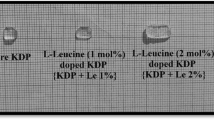Abstract
The dielectric constant and the dielectric loss of hydroxyl doped potassium chloride crystals have been explored in the temperature range between 1.5°K and 80°K with frequencies ranging from 105 c. p. s. to 3.3×108 c. p. s. The observed relaxation behavior is discussed in terms of one-phonon processes.
Résumé
On a mesuré aux températures de 1,5°K à 80°K et aux fréquences de 105 à 3,3·108 cycles/sec la constante diélectrique et les pertes diélectriques des cristaux de chlorure de potassium dopés de ions hydroxyles. En diminuant la concentration le temps de relaxation moyen s'approche d'une loiT −1, d'où l'on tire que le processus de relaxation est dû à l'émission ou l'absorption d'un seul phonon. On discute qualitativement l'influence des défauts et des interactions dipolaires.
Zusammenfassung
Die Dielektrizitätskonstante und die dielektrischen Verluste in Kaliumchloridkristallen, die mit Hydroxyd dotiert sind, wurden gemessen im Temperaturbereich zwischen 1.5°K und 80°K mit Frequenzen von 105 Hz bis 3,3·108 Hz. Mit abnehmender Konzentration nähert sich die durchschnittliche Relaxationszeit einemT −1 Gesetz, woraus geschlossen wird, daß der Relaxationsprozeß durch die Emission oder Absorption eines einzelnen Phonons erfolgt. Eine qualitative Diskussion des Einflusses der Kristallbaufehler und der Dipol-Dipol Wechselwirkung wird gegeben.
Similar content being viewed by others
References
Kuhn, U., andF. Lüty: Solid State Comm.2, 281 (1964).
Känzig, W., H. R. Hart, andS. Roberts: Phys. Rev. Letters13, 543 (1964).
see e. g.Kittel, C.: Introduction to Solid State Physics. 2nd edition, chapter 7. New York: Wiley 1956.
Brout, R.: Phys. Rev. Letters14, 175 (1965);W. Zernik: Phys. Rev.139, A 1010 (1965);M. W. Klein: to be published.
Field, R. F.: Dielectric Materials and Applications.A. von Hippel (ed.). New York: Wiley 1954.
Westphal, W. B.: Dielectric Materials and Applications.A. von Hippel (ed.). New York: Wiley 1954.
Kyropoulos, S.: Z. anorg. Chem.154, 308 (1926).
Känzig, W.: J. Phys. Chem. Solids23, 479 (1962).
Sussmann, J. A.: Phys. kondens. Materie2, 146 (1964).
Devonshire, A. F.: Proc. Roy. Soc. (London)A 153, 601 (1936).
Narayanamurti, V.: Phys. Rev. Letters13, 693 (1965).
Kuhn, U., andF. Lüty: Solid State Comm.4, 31 (1965).
Shepherd, I., andG. Feher: Phys. Rev. Letters15, 194 (1965).
Author information
Authors and Affiliations
Rights and permissions
About this article
Cite this article
Bosshard, U., Dreyfus, R.W. & Känzig, W. Dielectric relaxation in hydroxyl doped potassium chloride. Phys kondens Materie 4, 254–261 (1965). https://doi.org/10.1007/BF02422839
Received:
Issue Date:
DOI: https://doi.org/10.1007/BF02422839




